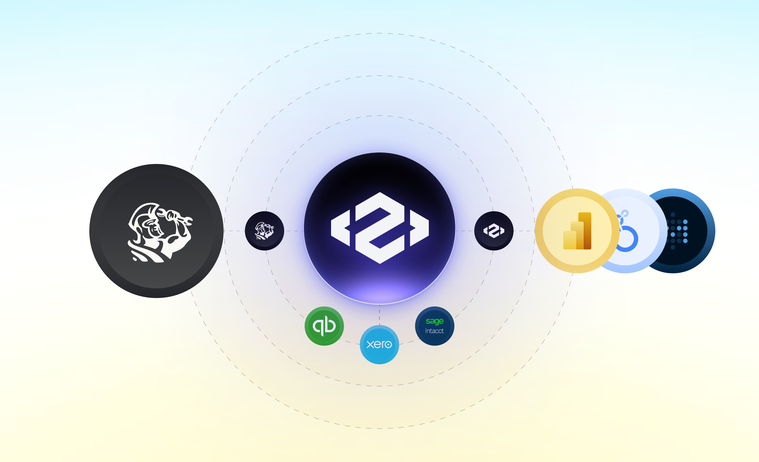How to Unify ServiceTitan + QuickBooks in One Reporting View
Home service businesses often find themselves running two different companies under one roof. The operations team lives inside ServiceTitan, monitoring dispatches, job status, and technician performance. The finance team, on the other hand, works with QuickBooks, Sage Intacct, or Xero, focusing on margins, revenue, and cost controls.
Both teams are looking at the same business. Yet, they often struggle to agree on what the numbers are actually saying.
This disconnect slows down decision-making, creates friction, and ultimately hurts growth. But with the right approach, it’s fixable.
Key takeaways
-
Ops and finance teams often work from disconnected systems: ServiceTitan and accounting platforms operate in silos, making it difficult to get a unified view of performance.
-
Manual reporting wastes time and leads to misalignment: Exporting data into spreadsheets slows teams down and creates conflicting reports that delay decisions.
-
Peaka bridges the gap with live, unified dashboards: By connecting ops and finance data in one place, Peaka enables real-time insights without the need for a data team.
One business, two realities
Picture this: Your operations manager claims the last two weeks were a win. Jobs were completed on time, techs were efficient, and revenue looked strong in ServiceTitan.
Then your controller runs the numbers in QuickBooks and reports that margins are down and job costs are trending in the wrong direction.
Who’s right? The answer often requires someone to manually stitch together data from multiple sources just to get a clear view. That takes time. And by the time the full picture emerges, the business has already moved on.
This is the reporting gap between ops and finance. And it’s more common than you think.
What the disconnect looks like in practice
When operational and financial data are siloed, confusion becomes routine:
-
Finance flags a drop in gross margin, but has no context on the type of jobs completed.
-
Ops highlights a high-performing technician, only to find their jobs are consistently unprofitable.
-
Executives ask for a board-ready report. Each team submits a different version of the truth.
This back-and-forth creates inefficiencies. More importantly, it prevents leadership from making timely, confident decisions.
Why bridging the gap is so difficult
For most growing contractors, the challenge isn’t a lack of interest. It’s a lack of infrastructure.
-
ServiceTitan focuses on scheduling, dispatch, and customer experience. It doesn’t natively track job profitability.
-
Accounting platforms like QuickBooks or Xero track financials but lack operational context.
-
There’s no internal data team to build custom integrations or reporting pipelines.
-
Buying off-the-shelf is not an option, as there are no products on the market that are purpose-built for the needs of home service businesses, but rather only enterprise-grade offerings that are expensive to purchase and costly to operate.
So teams fall back on what they know: Manual data exports, spreadsheet workarounds, and disconnected dashboards.
The result is a fragmented view of the business.
The cost of disconnected reporting
Falling back on manual data replication can be a short-term fix, but not a long-term solution for a company looking to grow. These companies will eventually have to face the consequences of working with different data sets:
-
Job profitability is often unclear until weeks later
-
Technician performance is misinterpreted without context on revenue or cost
-
Financial forecasts are built on assumptions rather than real-time metrics
These problems don’t just slow down reporting. They undermine the organization’s ability to operate effectively in a rapidly changing competitive environment. Without accurate visibility, it’s hard to plan new hires, expand into new markets, or adjust pricing strategies.
What integrated reporting actually looks like
A unified reporting system solves these problems by bringing ops and finance data into one shared dashboard. No more guesswork. No more conflicting reports.
Imagine dashboards that show:
-
Job revenue versus job cost per technician
-
Gross margin by job type or location
-
Real-time tracking of backlog and revenue targets
-
Marketing ROI alongside dispatch efficiency
Everyone works from the same data. Teams stay aligned, and leaders get the clarity they need to act fast.
How Peaka bridges ops and finance
As an official ServiceTitan partner, Peaka makes this kind of integration possible for home service businesses—without a data team or costly custom development.
-
Peaka connects directly to ServiceTitan and your accounting platform
-
It pulls in both operational and financial data automatically
-
Once consolidated and filtered, this data is then sent to BI tools like Looker Studio, Power BI, or Metabase for visualization
-
Everything is live, always up to date, and accessible from a single interface
With Peaka, you don’t need to choose between simplicity and sophistication. You get both.
Fix the gap, supercharge your growth
When operations and finance teams aren’t aligned on the numbers, growth becomes harder. Misunderstandings multiply. Reporting takes too long. And strategic decisions are made with incomplete information.
The fix is not more spreadsheets. It’s not more meetings. It’s a single source of truth—one that connects ServiceTitan and accounting data in real time.
Peaka helps you close the gap between ops and finance so your team can focus on what matters: running a better business.
Ready to streamline reporting and scale your services?
Sign up to Peaka for free today.
Book a quick demo and see how Peaka connects ServiceTitan and QuickBooks in minutes.




 Please
fill out this field
Please
fill out this field










